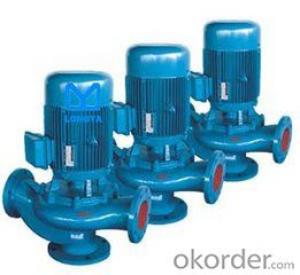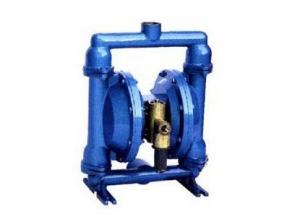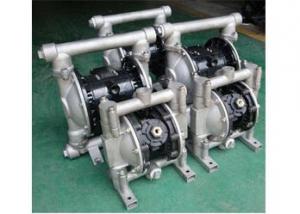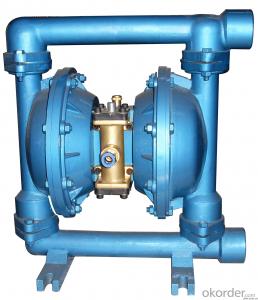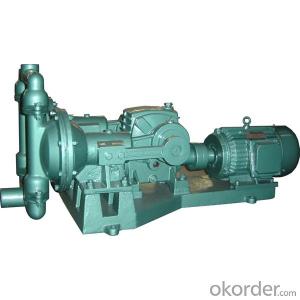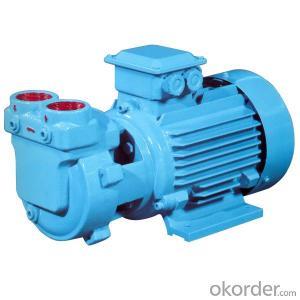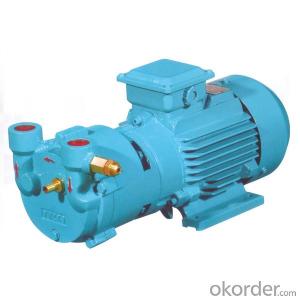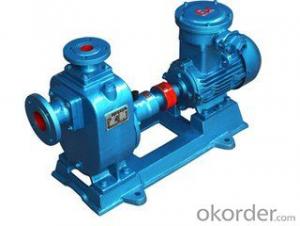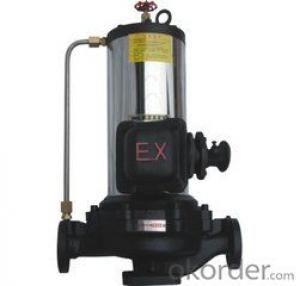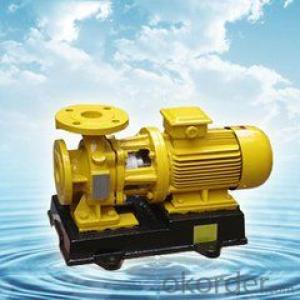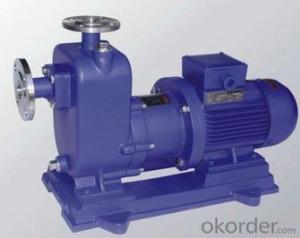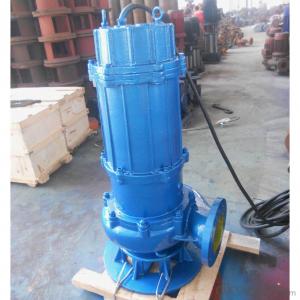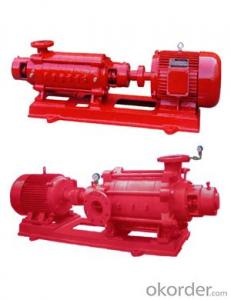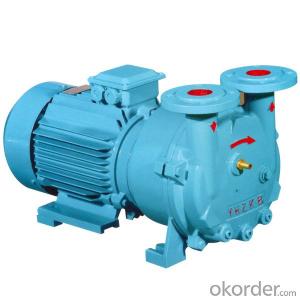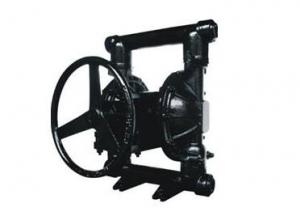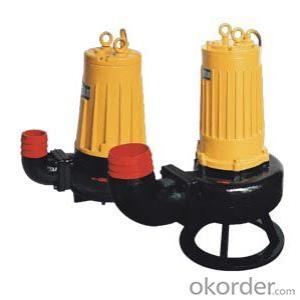GW TYPE Sewage pump 65 GW 25-15-2.2 DN65
- Loading Port:
- Shanghai
- Payment Terms:
- TT OR LC
- Min Order Qty:
- 5 unit
- Supply Capability:
- 20 unit/month
OKorder Service Pledge
OKorder Financial Service
You Might Also Like
A, product overview
This series of sewage pump is the introduction of the federal
republic of Germany ABS pump company advanced technology,
through the absorption and transformation of development,
various performance indexes reached the level of national standard
of similar products.Due to the unique, single (double) channel impeller
sewage capability is strong, can effectively by 5 times of pump diameter
of fiber content 50% of pump diameter and solid particles, dynamic seal
adopts two sets of special material of carbide mechanical seal device, the
material for cast iron and stainless steel.
Second, the product features
GW type pipe sewage pump is SG type based on the use of advanced
technology design and become the latest kind of pump.The pressurized
water pump can be used as general pipeline pump, and suction liquid
containing particles of impurities such as fiber, suspended solid impurities,
for chemical industry, textile, pharmaceutical, environmental protection
and other industries to provide the ideal conveying machinery.
Three, use the product
1, enterprise unit wastewater emissions;2, urban sewage treatment plant
emissions system;3 drainage station, subway, basement, civil air defense
system;4, hospital, hotel, high-rise building sewage;5, residential sewage
drainage station;6, municipal engineering, construction sites in the thin mud
emissions;7, tap water company's feed system;8, plants sewage several rural
farmland irrigation;9, exploration, mining and water treatment equipment;10,
water supply and drainage of water conservancy projects.
Four, model significance
For example: 200 gw400 30 P - 200 - outlet diameter (mm) GW - pipeline
sewage pump 400 - rated flow (m/h) 30 - rated head (m) P - the material is stainless steel
- Q: How does an air pump handle different altitudes?
- An air pump handles different altitudes by adjusting the pressure it generates to compensate for the changes in atmospheric pressure. As altitude increases, the atmospheric pressure decreases, which means there is less air density. To maintain the desired level of pressure, the air pump either increases the speed or volume of air it pumps, or it adjusts the pressure regulator accordingly. This ensures that the air being pumped into a tire, for example, remains at the correct pressure regardless of the altitude. Without this ability to adjust, the pump would not be able to deliver the necessary pressure at higher altitudes, leading to underinflated tires or inadequate inflation of other objects.
- Q: Can an air pump be used for inflating camping gear like sleeping pads or tents?
- Yes, an air pump can be used for inflating camping gear like sleeping pads or tents. Many air pumps come with different nozzle attachments that can be used to inflate various camping gear items. This makes it easier and more convenient to inflate and set up your camping equipment.
- Q: Can an air pump be used for inflatable stage props or decorations?
- Yes, an air pump can be used for inflating stage props or decorations. An air pump provides a quick and efficient way to inflate large objects, making it ideal for inflating stage props and decorations.
- Q: The 7.5kW motor pumps the generator and directly uses the diesel engine, which is economical
- The direct drive of a diesel engine with an air pump is certainly the most economical and simple. The main reasons are as follows:1, from the cost of equipment, eliminating the generators and motors, greatly reducing the cost of equipment.2, from the energy conversion and efficiency comparison, from the diesel engine - Generator - motor - pump in the middle of the energy consumption is relatively much greater.3, from the maintenance cost and use of operation considerations, diesel engine direct drive more economical.
- Q: Can an air pump be used for oxygen therapy?
- Using an air pump for oxygen therapy is not possible. Oxygen therapy necessitates the utilization of an oxygen concentrator or an oxygen cylinder, both of which offer a higher oxygen concentration than that found in the surrounding air. An air pump merely circulates air and lacks the ability to concentrate or deliver oxygen at the adequate levels required for oxygen therapy. To ensure the safety and efficacy of oxygen therapy, it is crucial to employ the appropriate equipment recommended by medical experts.
- Q: Are air pumps suitable for inflating exercise balls?
- Yes, air pumps are suitable for inflating exercise balls. Air pumps are specifically designed to inflate various types of inflatables, including exercise balls. They are portable and easy to use, usually equipped with different nozzle attachments that fit the valves of exercise balls. Using an air pump ensures that the exercise ball is properly inflated to the desired level, which is important for maintaining its stability and functionality during exercise routines. Additionally, air pumps allow for precise control over the amount of air being pumped into the exercise ball, allowing users to achieve the desired level of firmness or softness. Overall, air pumps are a convenient and reliable tool for inflating exercise balls.
- Q: Can an air pump be used for inflating inflatable pools with multiple chambers?
- Yes, an air pump can definitely be used for inflating inflatable pools with multiple chambers. In fact, using an air pump can make the inflation process much quicker and easier compared to manually blowing up each chamber. Air pumps are designed to provide a continuous stream of air, which is ideal for inflating multiple chambers simultaneously. Additionally, some air pumps even come with various nozzle attachments that can fit different valve sizes, ensuring a secure and efficient inflation process. Overall, using an air pump is highly recommended for inflating inflatable pools with multiple chambers.
- Q: Can an air pump be used for inflatable event decorations?
- Yes, an air pump can be used for inflatable event decorations. An air pump is a convenient and efficient tool for inflating various types of inflatable decorations such as balloons, arches, and inflatable characters. It provides a quick and reliable way to fill these decorations with air, saving time and effort compared to manually blowing them up. Additionally, air pumps often come with different nozzle attachments to fit various sizes and types of inflatables, ensuring that they can be easily filled with air. Overall, using an air pump for inflatable event decorations is a practical and convenient solution.
- Q: Can an air pump be used for inflatable trade show exhibits?
- Yes, an air pump can be used for inflatable trade show exhibits. In fact, it is the most common and efficient method of inflating these exhibits. Air pumps are designed to quickly and easily inflate large air chambers, which is exactly what trade show exhibits require. They are usually equipped with various nozzle attachments to fit different types of valves and ensure a secure and airtight connection. Additionally, some air pumps have adjustable pressure settings, allowing you to control the inflation level based on the specific requirements of your exhibit. Overall, an air pump is a reliable and practical tool for inflating trade show exhibits, saving you time and effort while ensuring a professional and visually appealing display.
- Q: Found in just half an hour after the blackout, after the call, the circulating water pump, pump not out, thanks to the power of the time is short, or really do not know what will happen, I pump in low cabinet, a power outage, the water pump to pump down gas pipes, the cabinet in the end the brothers, a good way, how can the pump placed above the tank, to solve the problem of water pump, I don't want to put a lid on the pump cylinder, affect the appearance, the two is too much noise
- Check valve or raise the air pump!
Send your message to us
GW TYPE Sewage pump 65 GW 25-15-2.2 DN65
- Loading Port:
- Shanghai
- Payment Terms:
- TT OR LC
- Min Order Qty:
- 5 unit
- Supply Capability:
- 20 unit/month
OKorder Service Pledge
OKorder Financial Service
Similar products
Hot products
Hot Searches
